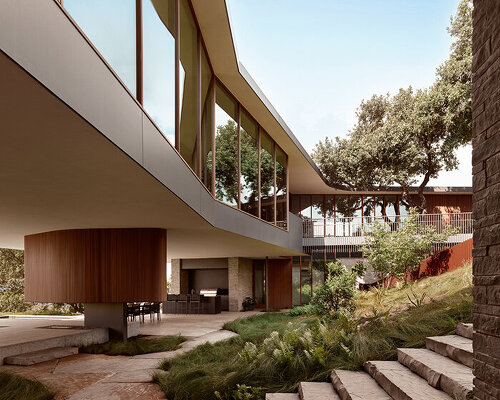city park Residence is Shaped by Site and View
Alterstudio perches this City Park Residence along a slope overlooking downtown Austin, interweaving the architecture into its verdant surroundings. The rolling hills outside the Texan city frame the urban skyline, with the Pennybacker Bridge appearing in the mid-ground. The design mediates between expansive panoramas and the intimacy of a sheltered courtyard, balancing openness with moments of enclosure.
Approaching the home, visitors move along a bridge that skirts mature oak trees and spans a carefully reshaped section of terrain, repairing the scar left by the demolition of the site’s previous structure. At the threshold, glimpses of the view give way to a U-shaped upper level. A service wing leads to public living and dining areas, where floor-to-ceiling glazing frames the landscape and opens onto a balcony that reveals the full expanse of the vista. Below, a sloping garden connects to a covered terrace, pool, and lawn. Exterior materials such as profiled wood, native stone, and mahogany window walls anchor the house in its context.
images © Casey Dunn
alterstudio’s Environmental Design and Energy Strategy
The architects at Alterstudio incorporate hybrid energy systems into the 7,600-square-foot City Park Residence, taking advantage of the site’s natural elements. Breezeways and roof apertures channel prevailing winds through the home, while deep eaves and solar shades temper solar gain. Extensive glazing provides daylight without sacrificing energy performance, supported by a high-performance building envelope with continuous exterior insulation.
Active systems complement the passive design moves, including a VRF HVAC system with MERV 13 filtration, hybrid electric hot water, high-efficiency lighting, and a photovoltaic array that enables net-positive energy performance. These measures, integrated into the architectural form, address both environmental responsibility and the health of occupants.
the house is set on a hillside overlooking downtown Austin
Adaptability and Long-Term Use
Alterstudio designs the City Park Residence as an heirloom for the client family, adaptable to shifting needs over generations. The primary living spaces and garage are located on the main level, supporting aging in place. Offices are planned to convert into bedrooms, and bathrooms can be reconfigured to accommodate future family members.
The home also integrates a safe room for protection during severe weather events. This emphasis on flexibility extends the residence’s longevity while enhancing resilience against the increasingly variable climate of central Texas, from extreme heat to winter freezes and power grid disruptions.
a bridge entry weaves through mature oak trees
a U-shaped plan frames both views and a private court
floor-to-ceiling glazing opens living areas to the landscape
exterior materials include profiled wood, native stone, and mahogany window walls
passive cooling uses breezeways, roof openings, and deep eaves
flexible layouts allow for aging in place and multigenerational use
design strategies address resilience to Texas’s power grid instabilities and extreme weather
project info:
name: City Park Residence
architect, interior designer: Alterstudio | @alterstudio
location: Austin, Texas
completion: 2025
photography: © Casey Dunn | @caseycdunn
design team: Kevin Alter, Ernesto Cragnolino, Tim Whitehill, Haifa Hammami, Daniel Shumaker, Matt Slusarek, Elizabeth Sydnor, Shelley McDavid
contractor: Rauser Construction
structural engineer: M. Scott Williamson
mechanical engineer: Positive Energy
geotechnical engineer: Holt Engineering
civil engineer: Aeparmia Engineering, PLLC
landscape: Hocker
pool: Design Ecology
The post alterstudio’s net-positive ‘city park residence’ bridges sloping site in austin, texas appeared first on designboom | architecture & design magazine.

